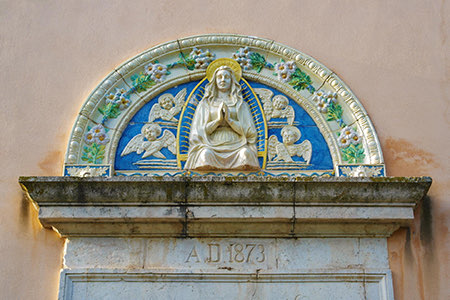
Saint Mary of Indulgences
Terracotta lunette
The domains of the Monastery of Sant’Angelo.
From its foundation until its closure (approximately 14431-14612), the Monastery of Sant'Angelo exercised an important economic, spiritual and pastoral role within the Land of Saint Benedict. The tangible testimony of this function was the dense network of dependent churches that the Benedictines of Valleluce founded throughout the abbey territory of Montecassino. Very often they were built in places originally inhabited by the Romans, reusing the materials of previous structures. Each one of them was characterized by a specific function3. Within the Diocese of Sora there were the churches of Saint Paul and San Valentine, in the Diocese of Marsi the church of Saint Cyricus and in the Villa Latina area the church of Saint Mary Magdalene. In the hamlet of Olivella there was the church of the Holy Cross. In the territory of Sant'Elia there were the churches of Sant'Onofrio and San Nicola. In the same area, the churches of Saint Mary of Indulgences, Saint Mary Major and Saint Mary of Palombara still exist and are open for worship. On the western side of Mount Raditto on the border with Valvori the ruins of The Most Holy Annunciation can be found and on Mount Cifalco the remains of the Oratory of Saint Bartholomew4.
The church of Saint Mary of Indulgences was founded at the beginning of the 9th century in the locality of Casalucense in Sant’Elia Fiumerapido. The Benedictines used to come to this place to announce the Indulgences that were granted each time to people. Originally, the church was built in the form of an aedicule, but starting from the 14th century, it was expanded and restructured many times thanks to the faithfuls. In 1840 two lateral apsed naves were added. In 1893 the vault, the dome and the pendentives were frescoed by the painter Enrico Risi from Sant’Elia. In 1957, thanks to the abbot Ildefonso Rea of Montecassino, the church was enriched with the frescos of Giovanni Bizzoni which represent the episodes of the life of the Virgin like the Birth, the Presentation at the Temple, the Marriage, the Flight into Egypt and the Marriage at Cana. The abbot also raised the church to the dignity of Marian Diocesan Shrine, which since 1991 has been kept by the Franciscan Friars of the Immaculate Conception5.
Open Google MapsThe church of Saint Mary Major was built around the 12th in the homonymous locality in Sant’Elia Fiumerapido. It served as a resting place for the Benedictines who used to travel between Montecassino and Valleluce. Its structure, with a single apsed nave, presents the portal on the right longitudinal side which is surmounted by a stupendous frescoed lunette with the Madonna and Child between the Archangel Michael and Saint Benedict. The interior is decorated with marvelous registers of votive frescos from various centuries, some of which are characterized by a Byzantine style, rich in sacred iconographies6. The presbytery has several exceptional fragments of pre-Cosmatesque floor mosaic made in marbles and hard stones7, which precede the extraordinary intact altar in its original form, dating to the foundation of the same church. The graceful wooden sculpture of the Madonna and Child, datable to the 17th-18th century6, is currently waiting for a new arrangement.
Open Google MapsThe chapel of Saint Mary of Palombara was built between the 12th and the 13th century in the Croce locality in Sant’Elia Fiumerapido. Located in the middle of two important religious communities, Saint Mary Major and The Most Holy Annunciation, it favored the spiritual recollection of the faithfuls residing in the countryside. Its simple structure, with a single apsed nave, reflects the typical characteristics of the so-called “rural” churches. The gabled facade is framed by two lateral buttresses while the portal is formed by two piers that both end with a corbel. Inside there are five small windows, one in the counter-facade and two on both side walls and at the bottom of the right side there’s a secondary door. On the back wall and in the apse there are the surviving frescos, probably from the 15th century of the Benedictine school, in which we can distinguish figures of Saints in different registers on the various layers of fresco. On the left the figure of the Madonna and Child stands out inside an almond shape8-9.
Open Google Maps